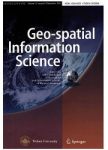Exploring metro vibrancy and its relationship with built environment:a cross-city comparison using multi-source urban data
作者机构:Guangdong Key Laboratory of Urban Informaticsand Shenzhen Key Laboratory of Spatial Smart Sensing and ServiceSchool of Architecture and Urban PlanningShenzhen UniversityShenzhenChina Ministry of Natural Resources(MNR)Key Laboratory for Geo-Environmental Monitoring of Great Bay AreaShenzhen UniversityShenzhenChina The Bartlett Centre for Advanced Spatial Analysis(CASA)University College London(UCL)LondonUK Department of Urban Planning and DesignThe University of Hong KongHong KongChina Department of Land Surveying and Geo-InformaticsThe Hong Kong Polytechnic UniversityHong Kong SARChina
出 版 物:《Geo-Spatial Information Science》 (地球空间信息科学学报(英文))
年 卷 期:2022年第25卷第2期
页 面:182-196页
核心收录:
学科分类:08[工学] 0814[工学-土木工程] 082301[工学-道路与铁道工程] 0823[工学-交通运输工程]
基 金:supported by the National Natural Science Foundation of China[grant numbers 42071360 and 71961137003] Natural Science Foundation of Guangdong Provinces[grant number 2019A1515011049] the ESRC under JPI Urban Europe/NSFC[grant number ES/T000287/1] the European Research Council(ERC)under the European Union’s Horizon 2020 research and innova-tion programme[grant number 949670] the Basic Research Program of Shenzhen Science and Technology Innovation Committee[JCYJ20180305125113883]
主 题:Urban vibrancy spatial-autocorrelation spatial lag model smart card data social media
摘 要:Recent urban transformations have led to critical reflections on the blighted urban infrastruc-tures and called for re-stimulating vital urban ***,the metro has been recognized as the backbone infrastructure for urban mobility and the associated economy *** date,limited research has been devoted to investigating the relationship between metro vitality and built environment in mega-cities *** paper presents a multisource urban data-driven approach to quantify the metro vibrancy and its association with the underlying built *** smart card data is processed to extract metro ridership,which denotes the vibrancy around the metro station in physical *** media check-ins are crawled to measure the vitality of metros in virtual *** physical and virtual vibrancy are integrated into a holistic metro vibrancy metric using an entropy-based weighting *** built environment characteristics,including land use,transportation and buildings are modeled as independent *** significant influences of built environ-mental factors on the metro vibrancy are unraveled using the ordinary least square regression and the spatial lag *** experiments conducted in Shenzhen,Singapore and London,this study comes up with a conclusion that spatial distributions of metro vibrancy metrics in three cities are spatially *** regression analysis suggests that in all the three cities,more affluent urban areas tend to have higher metro virbrancy,while the road density,land use and buildings tend to impact metro vibrancy in only one or two *** results demonstrate the relationship between the metro vibrancy and built environment is affected by complex urban *** findings help us to understand metro vibrancy thus make proper policy to re-stimulate the important metro infrastructure in the future.



